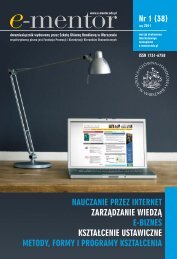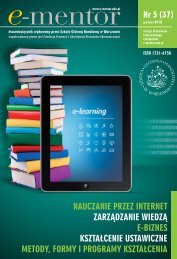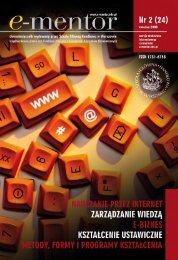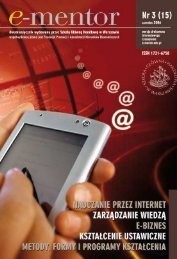Przerażony kameleon - eseje o przyszłości zarządzania - E-mentor
Przerażony kameleon - eseje o przyszłości zarządzania - E-mentor
Przerażony kameleon - eseje o przyszłości zarządzania - E-mentor
- TAGS
- kameleon
- eseje
- e-mentor.edu.pl
Create successful ePaper yourself
Turn your PDF publications into a flip-book with our unique Google optimized e-Paper software.
158<br />
Tomasz Magaj, Michał Mirowski, Andrzej Mróz, Adam Tomczak, Leszek Wojtowicz<br />
When thinking about the “future organization” it needs to be noted that our approach was<br />
not to imagine what we thought the world would look like in say 20 or 50 years. That position<br />
would have brought us to the level of trying to match the imagination of Alodous Huxley and<br />
the paper could be classified under science fiction in a creative writing class. In developing<br />
the structure of the future organization we were therefore limited by our pragmatic approach<br />
to maintain a semblance of reality of the organization yet at the same time daring to think of<br />
a brave new… organization. Taking the “classical” approach, therefore, we will first see how the<br />
organization of the future is structured and how it can function in a ultra-competitive business<br />
environment. We will then go on to describe “our company,” an organization functioning with<br />
success despite having little assets on the balance sheet and on the payroll. Finally, we will tie<br />
this all into the challenges that lie ahead and the benefits of modern technology.<br />
Organizational inter-dependence – then<br />
Over the centuries the model of the workplace changed, sometimes less sometimes more.<br />
The change brought on by the industrial revolution however, was significant because brought<br />
together in one place – the factory – many workers who would perform similar tasks all with<br />
the aim of producing a product that was a finished good made up of components ordered by<br />
the factory – raw materials – and either assembled on the spot or otherwise utilized to create<br />
a product comprised of the raw inputs. This revolution saw the advent of suppliers and created<br />
a supply chain, with the factory being a passage for the raw materials to pass through on route<br />
to the retailers and ultimately the consumer. This was a fairly simple road in the sense that it was<br />
straight: goods came into the factory in a parallel fashion from suppliers and went out in a linear<br />
fashion to the buyers. In this construct the suppliers acted as “feeders” of raw materials to the<br />
factory, more often than not unaffected by each other’s actions and not able to influence the<br />
strategy of the factory. The factory placed an order, they supplied. On the finished product side<br />
the story was much the same. The stores or other outlets for the goods produced ordered from<br />
the factory the produced goods and were shipped out to be sold. The players in the scheme<br />
were connected in a supply chain and were independent of each other, more often than not<br />
ignorant of each other’s existence and free from each other’s influence.<br />
Organizational inter-dependence – now and…<br />
This was the typical picture of a typical organization’s chain of production and supply, oversimplified<br />
yet fairly accurate. With that in mind, let us jump into the future, not too distant, and<br />
see how an organization (the future factory) in a particular field would behave. As we began the<br />
discussion with Forbes’ praise for the internet, we shall evaluate the challenges of tomorrow on<br />
the example of a 21 st century company using the internet in ways that were not available to the<br />
factory-owner and were probably not realistic to think of even 15 years ago.<br />
Our model of the future is based on a company providing a service, voice transfer, over the<br />
internet. Already today this is not and astonishing feat, as there are a few companies on the market<br />
already doing so. What makes this company unique is the organization structure and its utilization<br />
of the network and web built around it. Its chain or network of suppliers, service providers and<br />
what it in reality sells and how it works make the example of a very interesting case model.

















